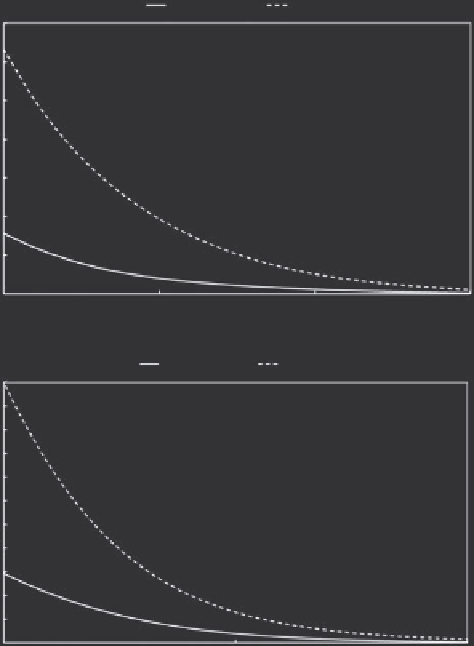Biomedical Engineering Reference
In-Depth Information
The real and imaginary parts of γ, β, and α, respectively, are
Muscle
Fat
70
60
2
α=ω
µε ′
ε
σ
ωε
00
(4.29)
1
+
−
1
2
ε
′
50
0
40
2
β=ω
µε
′
ε
σ
ωε ′
30
00
1
+
+
1
(4.30)
2
ε
0
20
10
where α (Np m
−1
) is the attenuation coefficient and β (radian m
−1
)
is the phase constant. In the engineering literature the penetra-
tion depth
d
is usually taken to be the distance into a medium
over which the electric field is reduced by a factor
e
. For plane
waves,
d
is determined using
0
5
6
7
8
Log
10
(Frequency (Hz))
Muscle
Fat
1.1
1
0.9
0.8
0.7
0.6
0.5
0.4
0.3
0.2
0.1
0
1
2
c
(4 . 31)
d
=
ω
.
2 2
εεε
′ + ′′ − ′
The wavelength in the lossy medium is given by
λ=
π
β
2
.
(4.32)
Since the dielectric properties of tissues are dispersive, then
the wavelength and attenuation are dependent upon frequency.
Figures 4.4 and 4.5, respectively, show these dependencies for
muscle and fat.
When investigating the energy transmitted via the electro-
magnetic field and/or deposited in tissues, it is useful to begin
by considering Poynting's theorem. This is a statement of the
conservation of energy in a volume contained within a closed
surface and can be expressed as
8
9
10
Log
10
(Frequency (Hz))
FIGURE 4.4
Frequency dependence of wavelength in muscle and fat
tissues. Upper: 100 kHz to 100 MHz. Lower: 100 MHz to 10 GHz.
surface
S
, and
P
cp
is the total average power transferred to the
charged particles within the volume. For steady-state sinusoidal
fields,
∂
∂
(
)
∫
∫
(
)
ε µ
EE
.
HH
.
+ +×
w V
EH S
.
d
(4.33)
0
cp
t
V
S
2
E
The volume integral in Equation 4.33 contains terms repre-
senting the instantaneous energy stored in the electric field, in
the magnetic field, and that possessed by charged particles, and
gives the instantaneous total energy within the enclosed volume.
he vector term
E
×
H
is known as the Poynting vector and rep-
resents power density (W m
−2
). The surface integral gives the
instantaneous total power passing out through the closed sur-
face. Thus, Equation 4.33 shows that the time rate of change of
the total energy inside
V
is equal to the total power passing out
through the surface
S
. For sinusoidal fields, the time-averaged
energy stored in the electric and magnetic fields is zero, and so,
from Equation 4.33, it follows that
0
(4.35)
P
=σ
.
cp
2
The specific absorption rate (SAR) is defined as the time deriva-
tive of the incremental energy (
dW
) absorbed by or dissipated in
an incremental mass (
dm
) contained in a volume element (
dV
)
of a medium of density ρ:
d
dt
dW
dm
=
d
dt
dW
dV
SAR
=
(4.36)
ρ
and has units W kg
−1
. From Equations 4.34 and 4.35 it follows
that the whole body averaged SAR, SAR
wb
,
is
∫
∫
−
PS
.
d
=
P
dV
(4.34)
cp
S
V
∫
P V
cp
where the parentheses represent time-averaged values, −
P
= −
E
×
H
is the total average power passing into the volume through the
SAR
=
V
(4.37)
wb
M






















